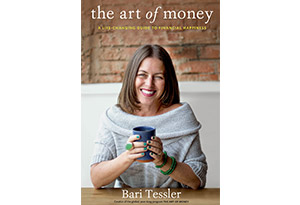Money Maps: The Solution to Your Budgeting Problems
Bari Tessler, the author of The Art of Money, shares an essential practice that helps define what a happy life looks like for you—and the financial goals to get there.

Photo: Loredana Nicu/EyeEm/Getty Images
Most traditional approaches to budgeting have us list out a single, Master Plan version of our income and expenses for the month. And while this may be helpful for some people as an initial money practice, it ignores the richness and complexity of our money relationship as something that is always unfolding, shifting, and evolving, over time. The Three-Tier Money Map is the antidote for this over-simplification.
Here is its basic framework:
1. The Basic Needs Level
These are the bare bones, bottom-line needs for your life. And only you decide what that means. Is it just groceries, rent, and utilities? Does it include a particular kind of food? Is a daily coffee a must for you to function? Does it include savings and debt repayment? You’re the boss here.
2. The Comfortable Lifestyle Level
Here, introduce some more comfort into your lifestyle. What’s the next level up from Basic Needs, for you? What’s included? How much? Does this mean a monthly (or even weekly) massage or pedicure? Some disposable income for movies, restaurant dinners, or the latest electronic gadgets? The ability to gift a little money to friends and family?
3. The Ultimate Lifestyle Level
Here we progress another step. Imagine having sufficient income to live out the fullest expression of your desires. All your intentions are funded. Does this look like millions of dollars in the bank, jet-setting from Tokyo to Buenos Aires to Paris, anytime you like? Or is it a surprisingly simple lifestyle, living debt-free on a rural sheep farm? Take the time to clarify what this means for you.
Everyone defines their Three-Tier Money Map differently: one person’s Comfortable tier is closer to another person’s Basic Needs or even Ultimate tier. Our definitions and dreams for each of these levels are as unique as we are, involving not only different types of expenses, but also vastly different amounts.
This Three-Tier framework is supportive and illuminating no matter what your income level or expenses are. Anyone can get out of control with their spending habits, bury their head in the sand about their income or debt, or lose focus of their priorities. And no matter how much or how little money you have, directing it with intention is always a pathway to greater clarity, connection, and empowerment.
 Adapted from The Art of Money: A Life-Changing Guide to Financial Happiness by Bari Tessler © 2016. Reprinted with permission of Parallax Press.
Adapted from The Art of Money: A Life-Changing Guide to Financial Happiness by Bari Tessler © 2016. Reprinted with permission of Parallax Press.
Here is its basic framework:
1. The Basic Needs Level
These are the bare bones, bottom-line needs for your life. And only you decide what that means. Is it just groceries, rent, and utilities? Does it include a particular kind of food? Is a daily coffee a must for you to function? Does it include savings and debt repayment? You’re the boss here.
2. The Comfortable Lifestyle Level
Here, introduce some more comfort into your lifestyle. What’s the next level up from Basic Needs, for you? What’s included? How much? Does this mean a monthly (or even weekly) massage or pedicure? Some disposable income for movies, restaurant dinners, or the latest electronic gadgets? The ability to gift a little money to friends and family?
3. The Ultimate Lifestyle Level
Here we progress another step. Imagine having sufficient income to live out the fullest expression of your desires. All your intentions are funded. Does this look like millions of dollars in the bank, jet-setting from Tokyo to Buenos Aires to Paris, anytime you like? Or is it a surprisingly simple lifestyle, living debt-free on a rural sheep farm? Take the time to clarify what this means for you.
Everyone defines their Three-Tier Money Map differently: one person’s Comfortable tier is closer to another person’s Basic Needs or even Ultimate tier. Our definitions and dreams for each of these levels are as unique as we are, involving not only different types of expenses, but also vastly different amounts.
This Three-Tier framework is supportive and illuminating no matter what your income level or expenses are. Anyone can get out of control with their spending habits, bury their head in the sand about their income or debt, or lose focus of their priorities. And no matter how much or how little money you have, directing it with intention is always a pathway to greater clarity, connection, and empowerment.
 Adapted from The Art of Money: A Life-Changing Guide to Financial Happiness by Bari Tessler © 2016. Reprinted with permission of Parallax Press.
Adapted from The Art of Money: A Life-Changing Guide to Financial Happiness by Bari Tessler © 2016. Reprinted with permission of Parallax Press.



